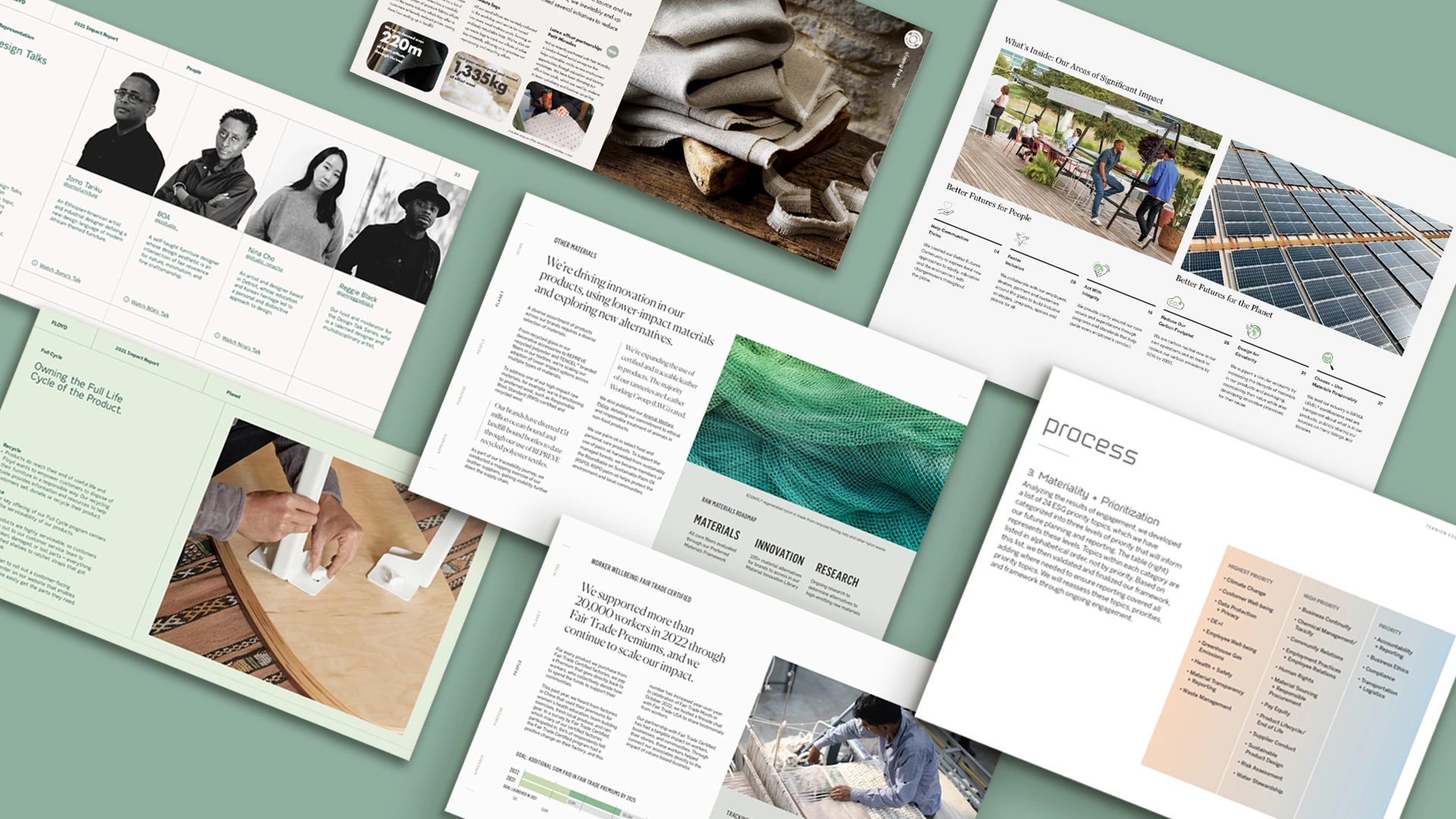
Impact Reporting: Understanding Your Impacts
01-May-2024
Building accountability into the furniture industry
Webinar & Action Guide Series
Welcome to part 2 of our Action Guide & Webinar series – ‘Impact Reporting for Change | Building Accountability Into the Furniture Industry.’ This series explores the transformative possibilities of impact reporting in the world of furniture.
This type of self-reporting invites furniture companies to measure, evaluate and ultimately take action to reduce the negative and increase the positive impacts of their business activities. The more companies that take up the challenge, the greater the collective shift of the industry toward sustainability. Our 3-part Action Guide aims to simplify the process.
Despite the hugely important role of furniture in our lives and our relationships, from our first cradle to our everyday desk, every item of furniture comes at a price in terms of our planet and everyone with whom we share it. All furniture has a back-story, a trail of impacts – whether it is wood-based furniture contributing to deforestation, imported furniture traveling great distances and contributing to climate change, foam-filled upholstery piling onto our mountain of plastic waste, or cheaply produced ‘fast furniture’ costing workers a fair wage.
These are the types of impacts we need to consider when designing, making or selecting furniture – and these are the impacts we need to identify and understand when we are creating an impact report. Welcome to part 2 of our 3-part Action Guide series:
- In Part 1, we looked at the purpose behind reporting, the benefits it brings and key content to include;
- In Part 2 we will explore the nuts and bolts of reporting – how to identify, understand and prioritize your impacts and where to find the information you need to build your report; and
- In Part 3 we will be exploring impact reporting as a tool for creating change within your company, turning data into a strategic plan that becomes a roadmap for change.
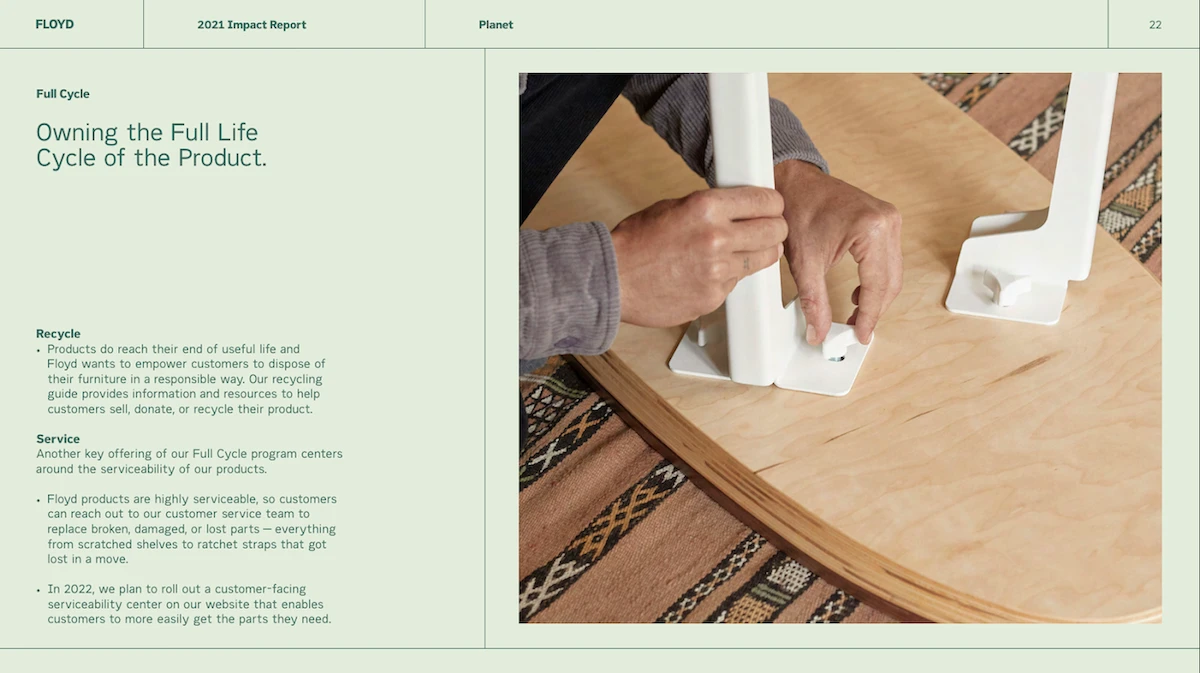
PART 2 of 3: Understanding Your Impacts
In this, our second Action Guide, we will be looking at ways of understanding the broader impacts of your business on people and planet. We’ll also explore materiality assessments, a commonly used method for prioritizing impacts - allowing you to focus on what will bring the most meaningful change. To save you time and effort, we will point out some of the places you should be able to find the data you need to start building your report.
Although most businesses will create a sustainability strategy some time before they think about creating their first impact report, ultimately, reporting helps shape strategy. By providing visibility into your impacts, reporting helps you set goals and targets and build a set of interventions to realize these goals.
Who does my business impact, and who impacts my business?
No business exists in a bubble - every business depends upon multiple interactions and relationships with a huge network. Even the smallest furniture company will impact the lives of many people up and down its supply chain – those who care for the forest, cut the trees, craft the table, and deliver it to the store – and onward to the customer who takes it home.
There are two elements to the impacts of a business, the impacts on the natural world and the impacts on people. The very first step in creating an impact report is to think about who your furniture business impacts. This is known as ‘identifying your stakeholders’ -- and includes ANY individual or group that is affected by your business activities as well as any individual or group who can affect your business. Ask yourself - ‘Who does my business impact, and who impacts my business?’
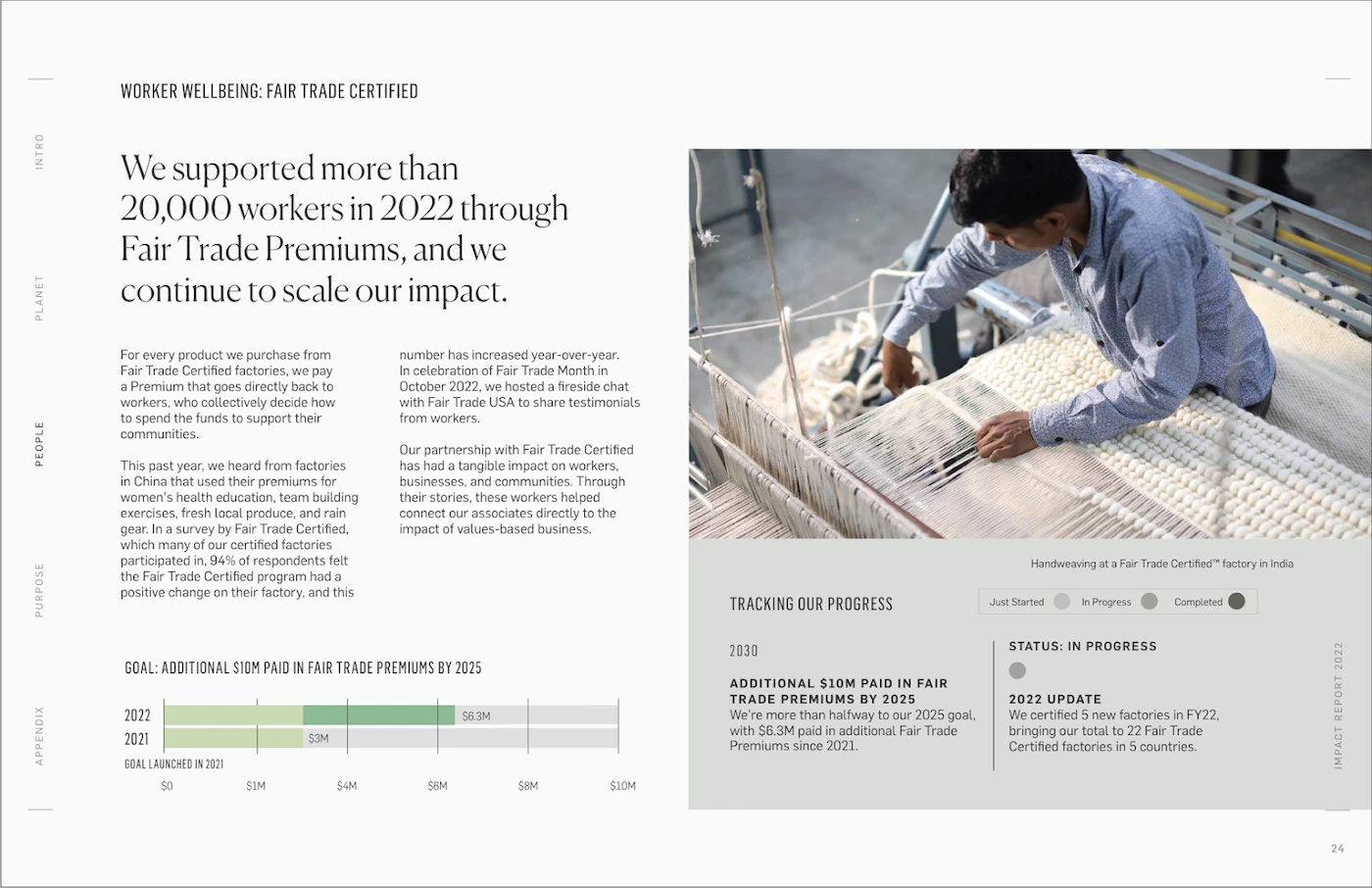
In its 2022 Impact Report, Williams-Sonoma acknowledges that all workers are impacted by labor standards and notes that the company values workers in its own supply chain by paying a fair trade premium.
From customers to certification bodies -
count and prioritize your stakeholders
Draw up a list and start thinking about which of your stakeholders are most affected by, or can most affect, your business.
Perhaps the most obvious stakeholder group is your customers. Depending on your business model, this group is likely to be the most influential. Customer demand for more sustainable furniture is a key driver for change. As awareness grows, so do customer expectations. Read on for ways to engage your customers and better meet their expectations.
Staff make up another key stakeholder group, one that will likely both affect and be affected by your business activities. Staff have the power to influence sustainable behavior and are the most directly affected by decisions on social issues such as pay, wellbeing, diversity, inclusion and ethical employment considerations. They have a vested interest in the way your company is governed, and their collective influence on day-to-day activities can be huge.
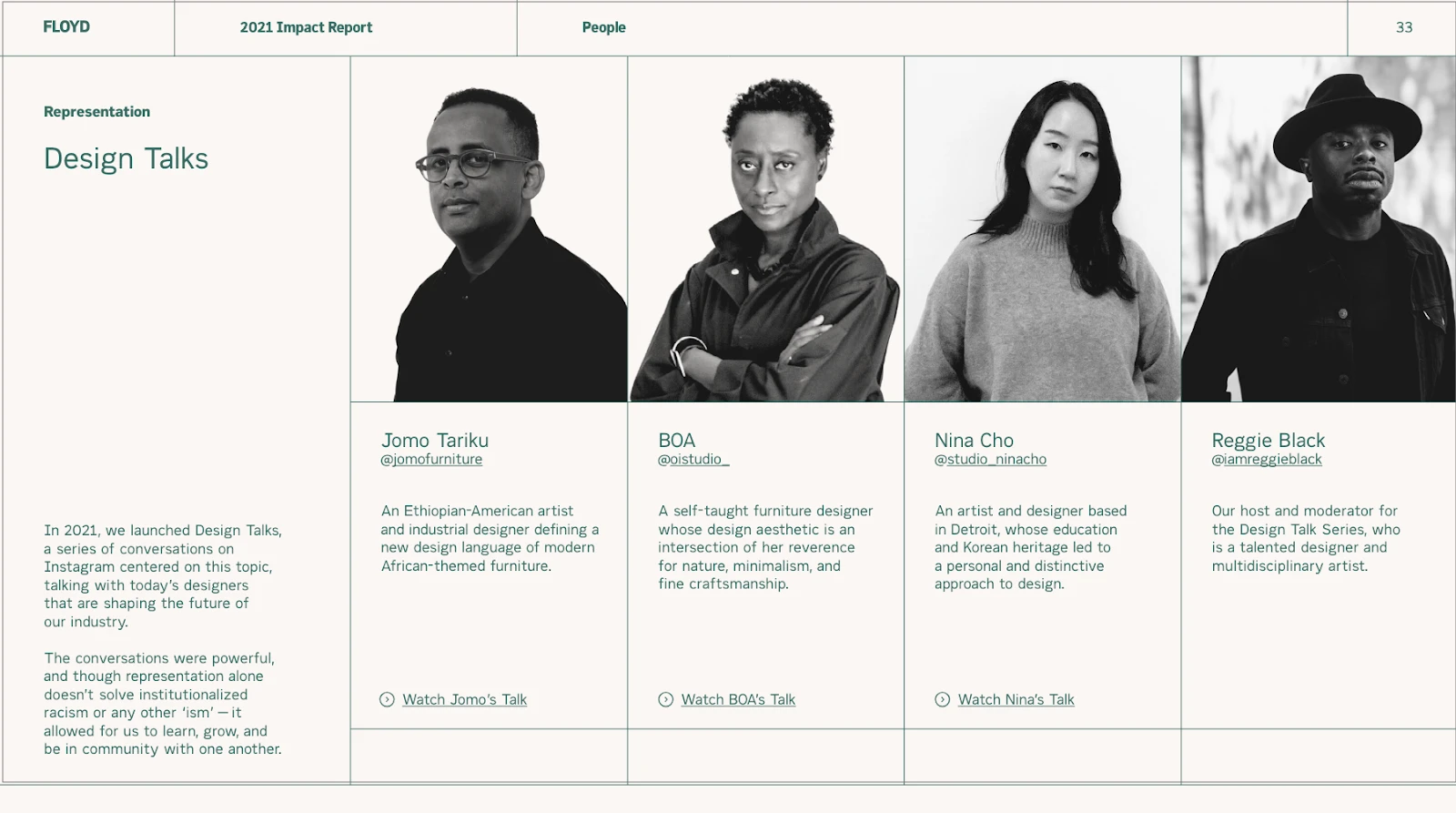
A Detroit-based manufacturer, Floyd, identifies one of its stakeholder groups -
designers - in its 2021 Impact Report.
Your local community – neighbors, local businesses, schools and community groups – will be significantly affected by your business (think employment opportunities, sponsorships and donations, as well as noise, litter and traffic) – and may have a significant impact on your business. Local colleges, for example, can become a source of future employees.

In its 2023 Impact Report, Steelcase identifies its community of dealers
as a key stakeholder group.
Your company’s shareholders or owners are also stakeholders. They will expect a reasonable return on investment, and will have varying levels of input and interest in terms of sustainability. In companies where shareholders or owners are the driving force behind the sustainability push, you may get a lot of investment in your reporting efforts. The likely influence of these shareholders will be much more positive than in companies that lack support from those at the top.
Your suppliers are another key stakeholder group. They are likely to have a significant impact on your environmental sustainability and supply-chain impacts – think through your entire supply chain, and take into account factors including their labor practices, energy and water use, timber sourcing and more.
Less obvious stakeholders include certification bodies such as the Forest Stewardship Council (FSC), SCS Global Services, WELL and LEED; non-profit networks such as the International Living Future Institute (ILFI) and resource centers such as the Sustainable Furnishings Council.
Your competitors are also stakeholders and – if you share best practice – they can sometimes become part of your wider sustainability network. Regulators like the U.S. Environmental Protection Agency (EPA) are a key stakeholder and one you ignore at your peril !

Global furniture giant IKEA identifies its stakeholders in its 2023 Impact Report to include co-workers, communities, suppliers and partners, customers, and a final, very broad group termed ‘partners and collaborators.’ This last category includes universities, governments, philanthropies and non-governmental organizations (NGOs) such as the Ellen MacArthur Foundation and UNICEF.

In its 2023 Social Responsibility Report, employee-owned US manufacturer KI
has used a really simple design to show the priority of its stakeholders.
As you draw up a list of all the people that your business impacts and everyone that can affect your business, sort them into priority order. At the top, for example, you might have your customers and local community and, at the bottom, certification bodies and non-profits. For other companies, priority stakeholders may line up quite differently. The order will depend on your business model. US-based manufacturer KI, for example, identifies its employees, suppliers, customers and investors as its highest priority stakeholders.
Build relationships with the people that matter
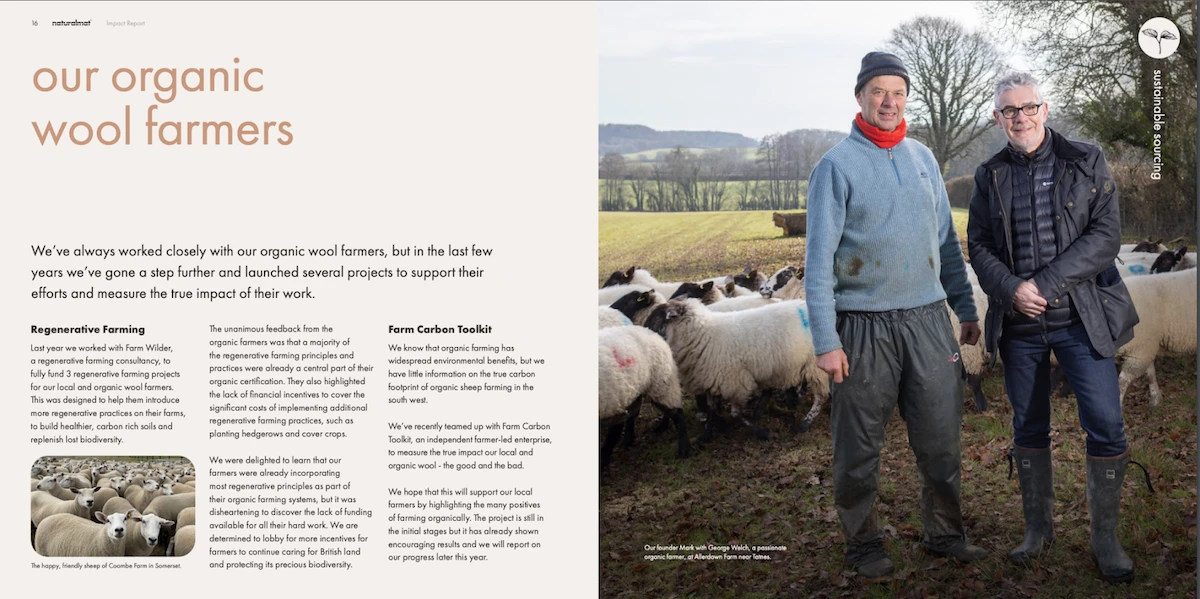
Now, with a clearer understanding of your stakeholders, start thinking about how you might further develop and build relationships with them. This process of ‘stakeholder engagement’ is important as you can call upon these relationships to help you understand and prioritize your impacts. Engagement creates a two way flow of communication that helps you address the issues most important to your stakeholders.
How do you engage, or further engage, with key stakeholders? One example might be contacting your customers for feedback, or reaching out to local schools or community groups for their opinions. Large furniture businesses will implement all kinds of strategies – such as running focus groups, sending out surveys, and meeting suppliers. If you are a small enterprise, with limited resources, focus on the stakeholders that are most interested and have the greatest power and influence. You might, for example, only reach out to your customers and suppliers.
Humanscale's 2022 Impact Report details its stakeholder engagement process and actions subsequently taken as a result of the topics discussed and concerns raised.
Remember to try to keep your antenna as inclusive as possible, especially when it comes to underrepresented voices. Often it is underrepresented communities that bear the brunt of many impacts - this includes, for example, Indigenous Peoples who dwell in the forest from which the wood is sourced, marginalized groups living close to factories and the air pollution they cause, and communities along coastal areas that tend to accumulate plastic packaging waste. Mother Nature herself also suffers a legacy of impacts from deforestation to water pollution but has no direct voice.
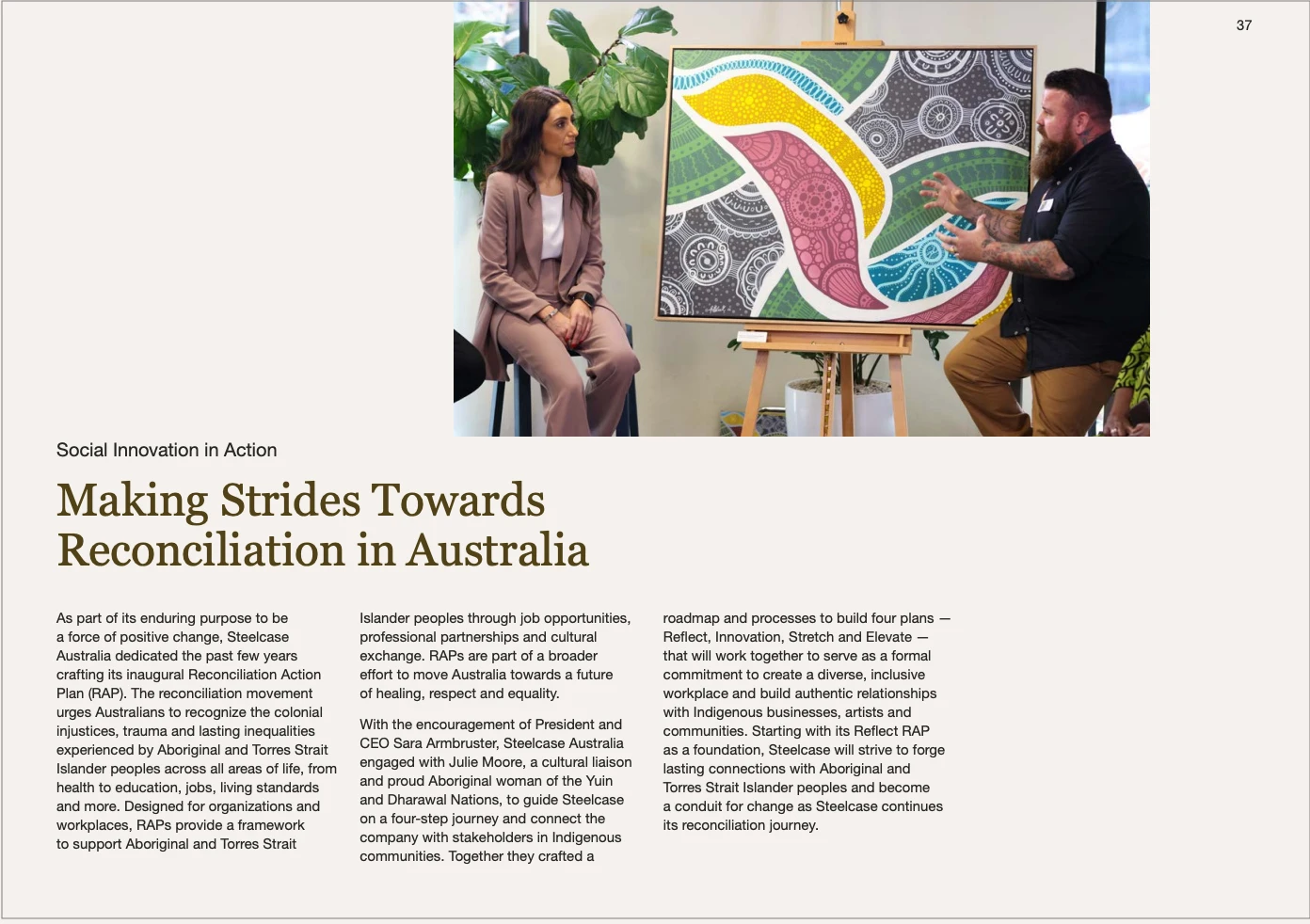
Perhaps the most common group to engage is your customers. It is vital to meet customer expectations – or they will shop elsewhere. If you already have good communication with your customers about sustainability-related issues, great. If you don’t yet, we set out a simple method below for obtaining feedback and increasing customer engagement. It is a pretty straightforward process that can yield surprising and valuable results.
Teknion – a Canadian workplace furniture manufacturer -- sets out its stakeholder engagement process very clearly in its 2024 ESG Report. It focused on two key stakeholder groups - customers and employees. Teknion sent surveys to all employees, interviewed its executive committee members, and conducted surveys and interviews with representatives of the architect and design community, furniture dealers and end customers.
What does my business impact,
and what impacts my business?
The next step is to prioritize the areas of impact that you will track. This can be tough, but it is critical to prioritize or the process can become overwhelming. One way to sort impacts into a manageable order is to carry out what is known as a ‘materiality assessment.’ When we talk about ‘material’ topics or ‘materiality’ in reporting, what we mean is – ‘Does this topic have relevance and significance? Is it meaningful and worth tracking?'
In financial reporting, ‘material’ topics refers to issues that could significantly influence the decisions of investors. In sustainability, or impact reporting, ‘material’ topics relate to your stakeholders – rather than to just your shareholders – and refer to any issue that could significantly affect economic, environmental or social outcomes.
Material topics are not just those that a company can impact -- such as air quality or deforestation – but also those that can impact a company. Climate change is perhaps the most common material issue cited by businesses. Note the ‘two-way street’ -- business activities impact climate change, through emission of greenhouse gasses and all along the value chain from harvesting or extracting raw materials to end of product life. AND climate change impacts business activity – from extreme weather events to resource scarcity and supply chain disruption.
Once you have identified your stakeholders and can answer ‘Who does my business impact, and who impacts my business?’ – you next need to answer ‘What does my business impact, and what impacts my business?’ Identifying and prioritizing these material issues forms a key part of your impact reporting process.

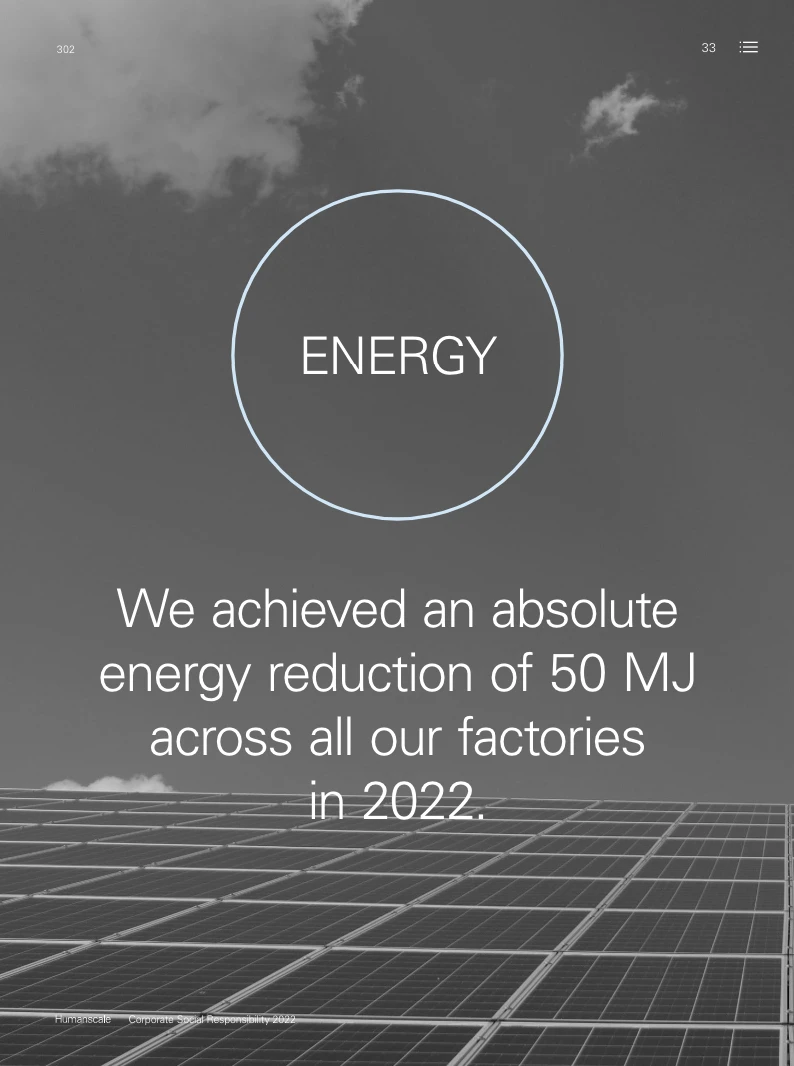
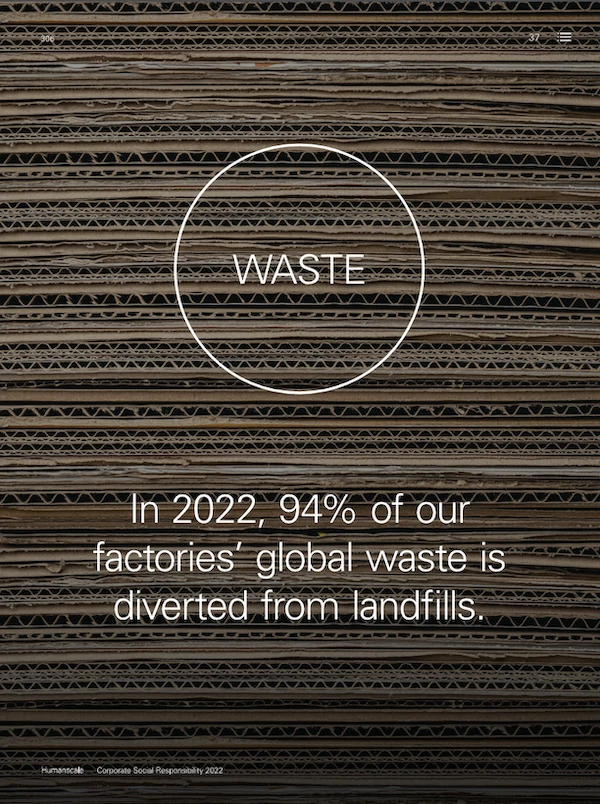

Humanscale, a US-based manufacturer, identifies some of its most material topics as greenhouse gas (carbon) emissions and climate change, energy use, waste, and biodiversity. In its 2022 Impact Report, the company details its efforts in these areas of impact – from helping restore native species to reducing electricity use.
The 5 steps to a materiality assessment
A materiality assessment gives a really clear map of the issues and topics your business needs to address, providing valuable insights and ultimately, a steer on your strategy. It allows you to compare and contrast your business’ own perspectives on its most important impacts with the perspectives of external stakeholders about your company’s most important impacts. Look for areas of impact where these perspectives converge – these are likely the most important to prioritize. A business may still choose to emphasize what it views as its most material topics.
Overall, without actively reaching out and asking, it’s common for companies to make assumptions about what matters most to stakeholders rather than hearing it first hand. A materiality assessment gives clear, quantifiable results that can be tracked over time to see shifting patterns and helps bring focus and clarity to what can be an incoherent array of material topics.
1. GATHER YOUR TEAM AND BRAINSTORM
Gather a team from within your company that is as wide and inclusive as possible, reflecting a range of roles, levels of seniority and activities within the company. In a really small business, this might be just one or two colleagues. Ideally, furniture companies will seek to include several people from across all departments, reflecting as many job functions as possible.
Set aside a good hour to throw ideas into the ring – What are the key environmental and social issues relevant to your company? What are the sustainability risks associated with your business activities?
Whatever ‘impacts’ you identify, keep them as relevant as possible to your everyday business activities. If you are a steel cabinet manufacturer, for example, you will need to consider energy use in manufacturing – and its significant risk of contributing to climate change. If you are a mattress manufacturer, you might consider product end-of-life issues related to the foam in your mattresses – and the risk of increased waste going into landfill. If you import furniture from Asia, you might consider wages paid to artisans and the risk of unfair labor practices.

In its 2023 Sustainability Report, Bisley, a UK manufacturer, identifies its staff as key stakeholders – and workplace wellbeing and gender equality as two of its material topics.
During brainstorming, take good notes not only about the risks associated with each activity but also the opportunities that present themselves. Returning to the examples above – a steel cabinet manufacturer might focus on purchasing renewable energy, decarbonizing its fleet, and introducing resource efficiencies into production (see Bisley, for example); a foam mattress manufacturer might explore natural fiber alternatives (see Naturalmat). A furniture importer might begin to pursue practices associated with fair trade and ethical employment (Nkuku).

Humanscale, in its 2022 CSR Report, grasped the opportunity of using
ocean-bound plastic as a lower impact material in its manufacturing process.
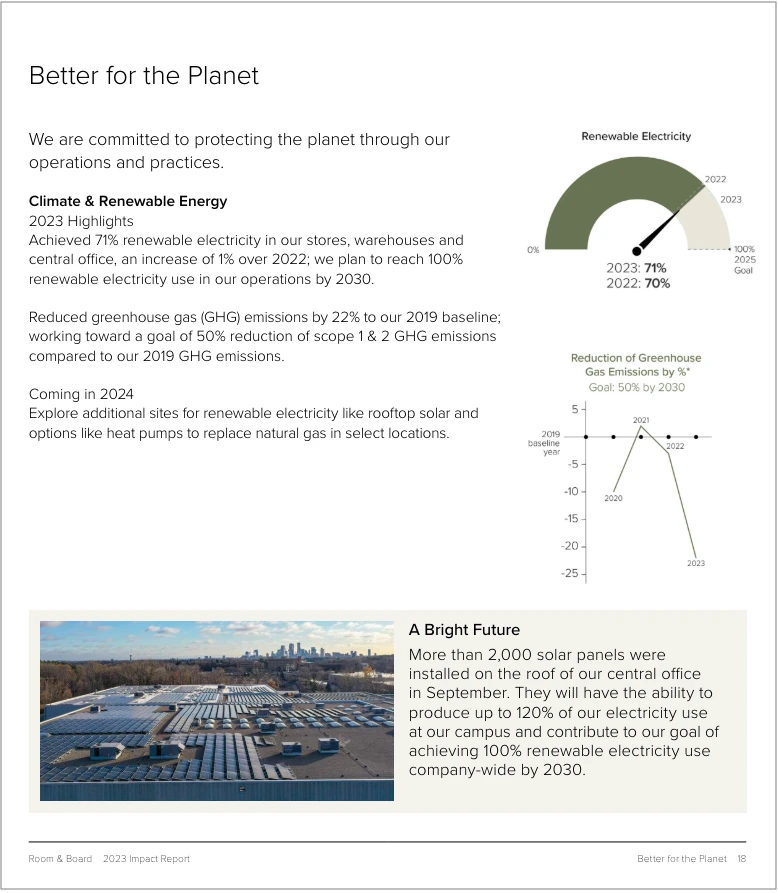
In its 2023 Impact Report Room & Board identified energy use and
greenhouse gas emissions as material topics. The opportunity they spotted was to
self-generate electricity. In fact, Room & Board’s headquarters now generates
more electricity than the building uses!
In part 3, the next in this Action Guide series, we will dive deeper into how a risk and opportunity based approach can lead to strategic sustainability-based decisions.
Meantime, in determining your main impacts, it’s important to focus on what is most relevant to your business. This is key to avoiding becoming overwhelmed by the many topics that you could report on!
The table below shows some of the topics considered ‘material’ to the furniture industry. Many of these topics are included in the Sustainability Accounting Standards Board (SASB), Global Reporting Initiative (GRI) and European Sustainability Reporting Standards (ESRS). In addition to mandatory topics for these reporting frameworks, the table also includes non-mandatory topics that are frequently reported on.

This table – listing examples of material topics for a furniture manufacturer –
is divided into environmental, social and governance categories.
2. PRIORITIZE AND SCORE YOUR IMPACTS
Once you have a big list of topics, the next step is to rank them in priority order – so that you can begin to focus on your most material topics. What issues have the biggest impact because of your business, and what topics have the biggest impact on your business? Every participant in your focus group needs to score each topic from one to five (or 1-10 if you want more nuanced results), with one being the least important/‘material’ and five being the most. This will generate a lot of helpful discussion on differing opinions among these rankings!
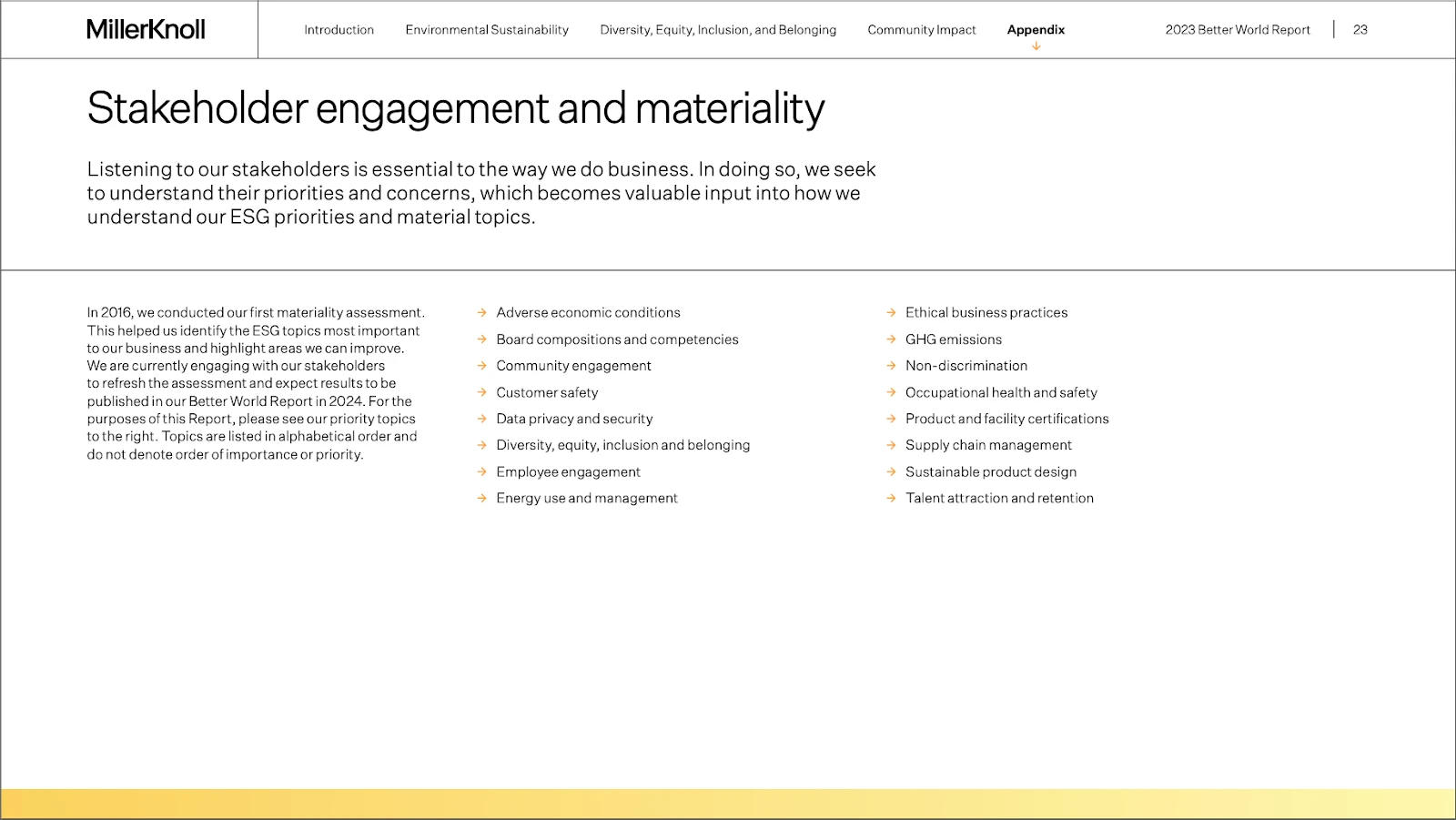
In its 2023 Better World Report, MillerKnoll, a US-based office furniture manufacturer, identified some of its material topics as: adverse economic conditions, employee engagement, talent attraction and retention, and board composition and competencies (who is in governance positions and what are the skill sets of each). These were ranked alongside some of the more commonly identified topics for furniture companies, such as GHG emissions, supply chain management and sustainable product design.
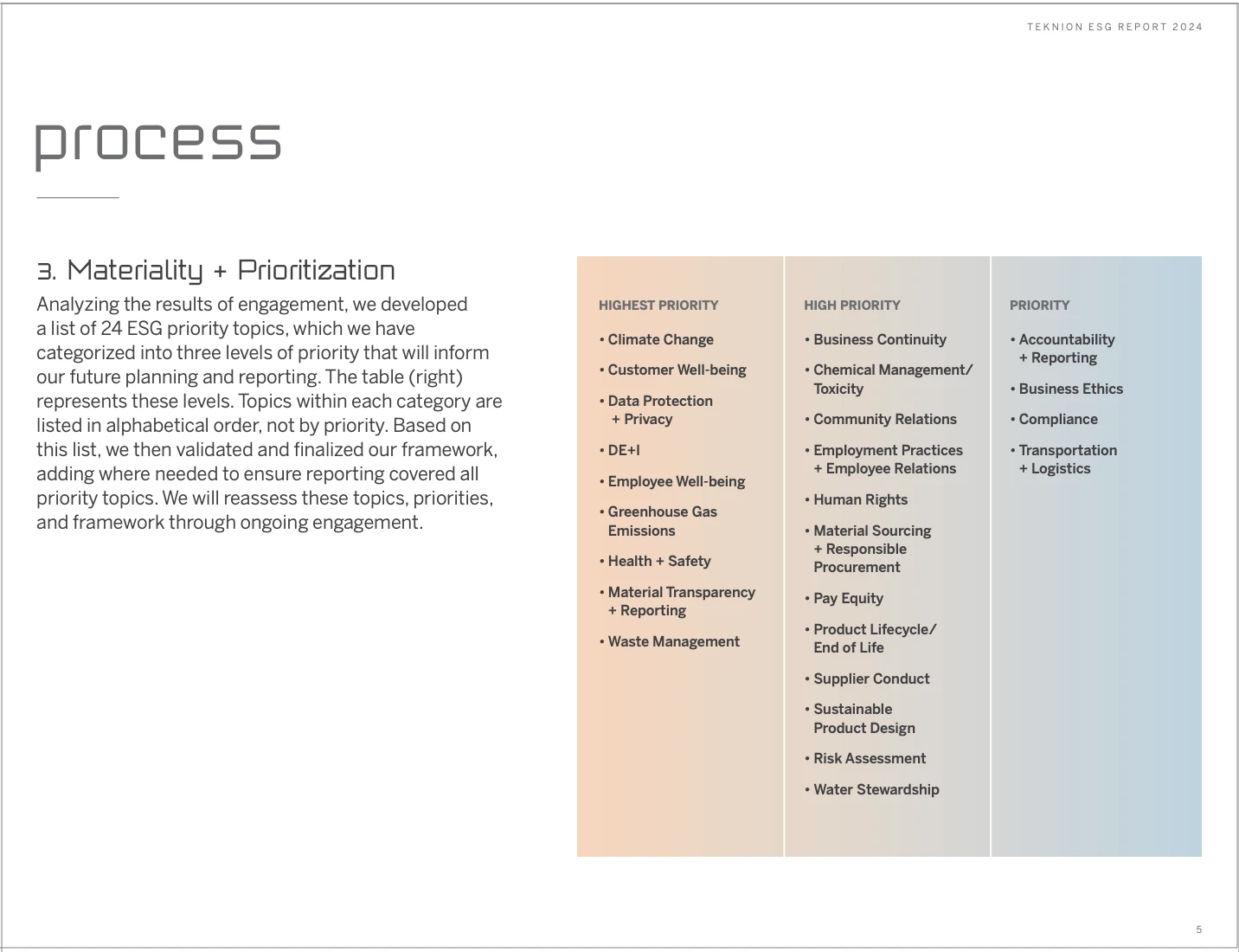
In ranking its highest priority topics, Teknion’s 2024 ESG Report identifies climate change and GHG emissions, customer and employee wellbeing, health and safety, DEI, data protection and privacy, waste management, and material transparency and reporting.
Add up each of the scores per topic, then divide the total for each topic by the number of participating colleagues (keep a good record of these scores). This will result in a list of material topics all scored between 1-5 (or 1-10), and hopefully distributed across this scale. Your top scorer, for example, might be climate change -- in terms of both extreme weather events and supply chain disruption as well as your furniture’s contribution to carbon emissions. Water use, by contrast, might only rank as a 1 because your annual use is low and you do not operate in an area of water scarcity.
3. ASK EXTERNAL STAKEHOLDERS TO RANK YOUR IMPACTS
Let’s say you start by carrying out a materiality assessment with your customers. You might end up with material topics ranked externally that look quite different to how you ranked them internally.

Steelcase identifies its top six material topics – 3 “for people” and 3 “for the planet” – then clearly sets out the steps the company is taking to mitigate those impacts.
4. GET YOUR GRAPH PAPER
Time for a bit more math - plotting each priority topic on a chart to create a ‘materiality matrix.’ The x axis (horizontal axis) represents your business’ internal rankings, while the y axis (vertical axis) represents impacts as ranked by external stakeholders. This will result in a visual representation of the top priorities as ranked by the business and by stakeholders. These priorities may shift over time; keeping clear records each time you repeat this process can be really helpful in predicting what might become more pressing in the future.
For instance, if both your company and your stakeholders ranked energy management a 5, it would sit in the top right quadrant of the materiality matrix. If stakeholders ranked biodiversity a 1 but the company ranked it a 5, it would sit bottom right. If stakeholders ranked waste management a 4 and the company ranked it a 3 it would sit near the center, and so on.
Noting these differences in perception positions your company to keep track of stakeholder concerns and consider reprioritizing high stakeholder concerns as the sustainability landscape shifts. It is only in recent years, for example, that circular economics has become such a high priority for stakeholders. Without carrying out a materiality assessment, this could be missed.
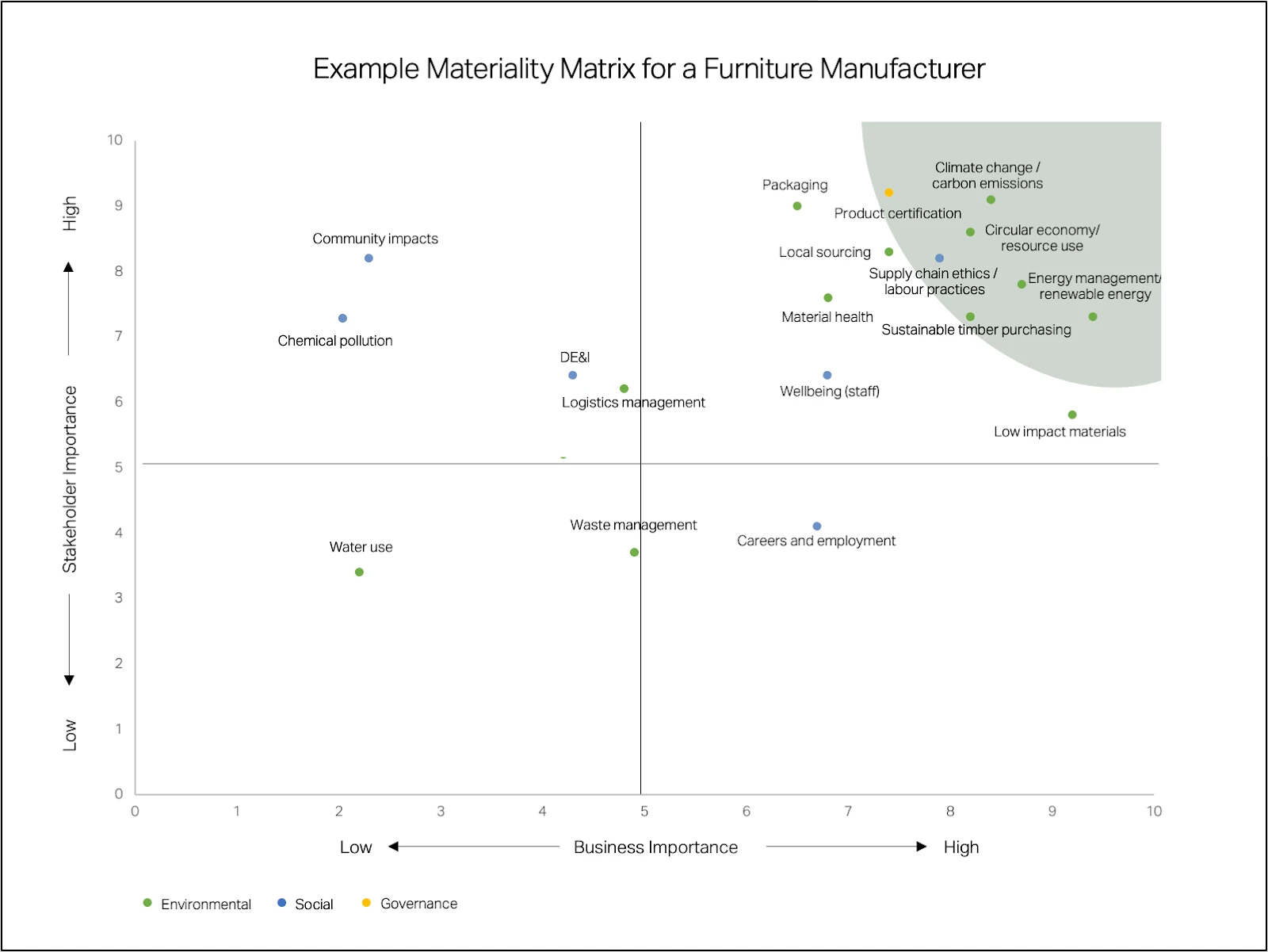
The example materiality matrix above uses a 1-10 scale and shows a very simple matrix of material topics ranked by both internal and external stakeholders. See how logistics management is ranked as a 6 by stakeholders and 5 internally, so – as both perspectives are similar – it sits near the middle of the graph. Low impact materials, by contrast, is ranked 9.5 in importance within the business but only 5.5 by external stakeholders; because of this difference in internal and external perspectives, you’ll see this topic sitting near the midpoint line on the y axis but into the upper right quadrant.
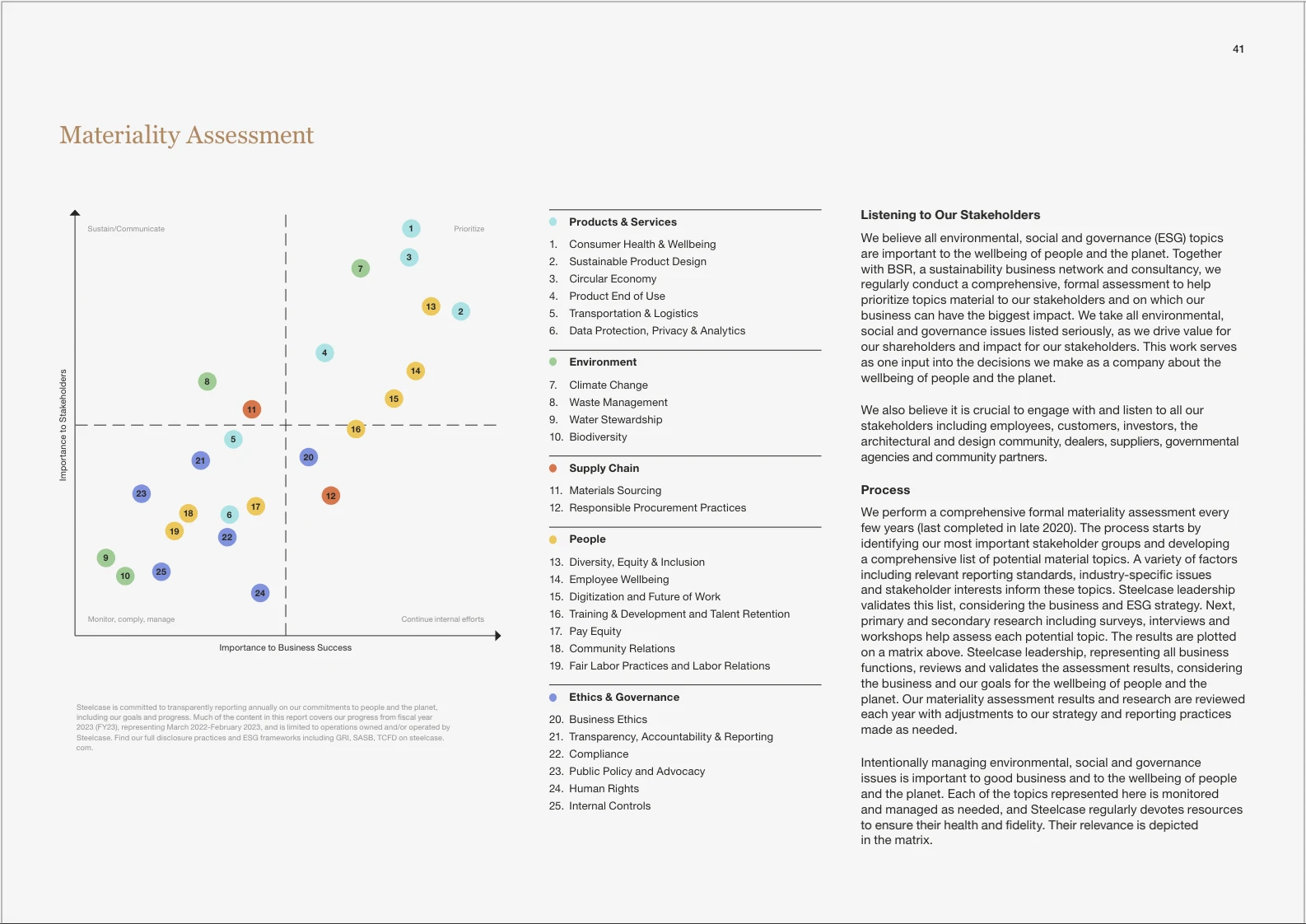
Steelcase Impact Report 2023 shows – see the top right quadrant – sustainable product design, DEI (diversity, equity and inclusion), climate change, consumer health and wellbeing, product end-of-use, and the circular economy to be the most pressing issues. At the same time, the report showed water stewardship and biodiversity ranked lowest priority to the business, while human rights issues were the least important to stakeholders (possibly because they assumed that no human rights abuses take place within this value chain). Steelcase also identified employee wellbeing and digitization and future of work as priority material issues.
5. FOCUS YOUR EFFORTS
Below is another example of a materiality matrix – this time from Room & Board’s 2022 impact report. In comparing materiality matrices of European and US-based companies, it is interesting to note that European businesses tend to focus more on circular economy and embodied carbon of products, as well as on operational carbon emissions across scopes 1, 2 and 3. US-based companies, by comparison, tend to focus more on Diversity, Equity & Inclusion (DEI) and chemical management in products. Differing stakeholder concerns by region can influence decision making and strategy development.
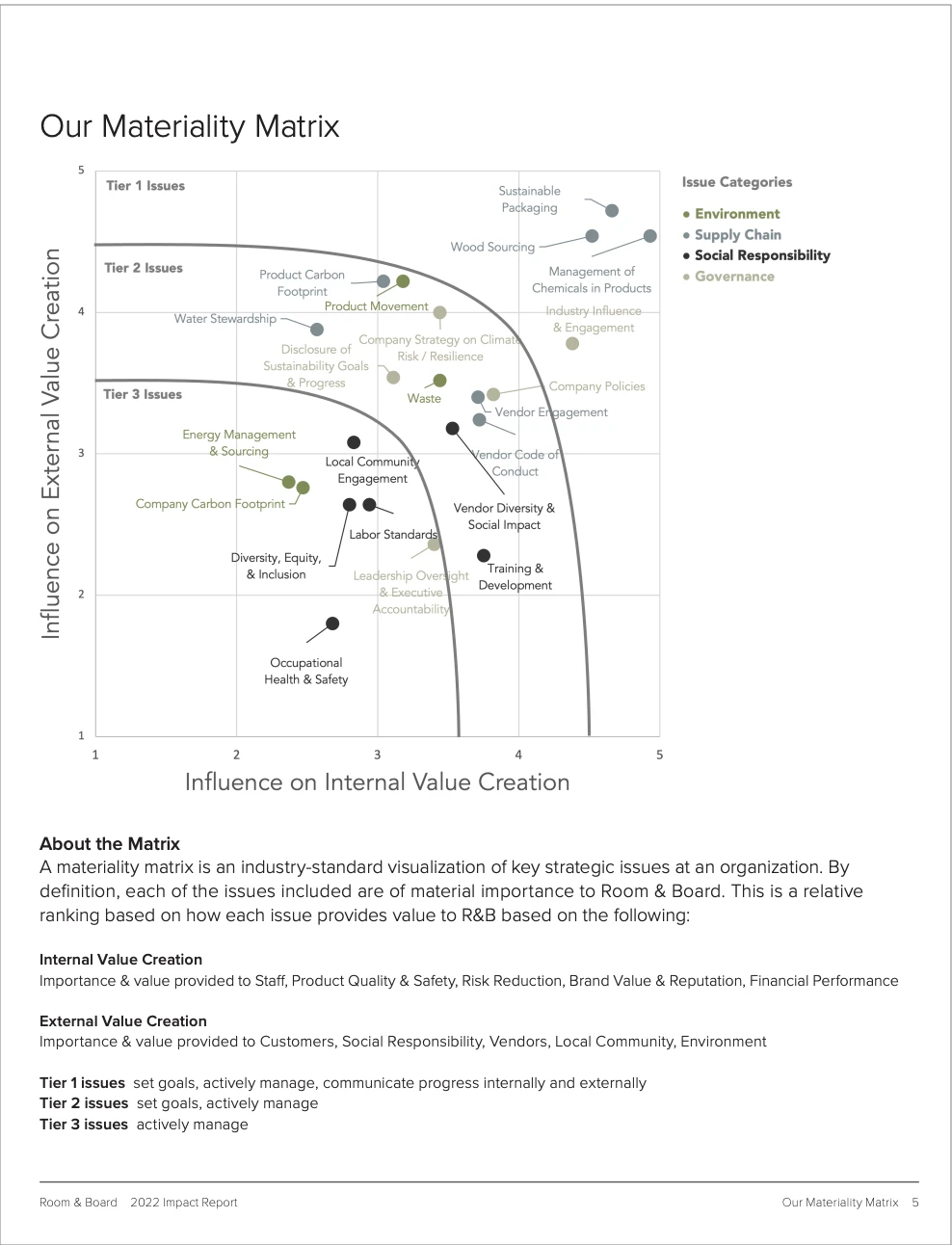
In the materiality matrix from its 2022 Impact Report, Room & Board identifies the company’s most material issues as: packaging, chemical management in products, wood sourcing and – in the governance category – industry influence and engagement. Energy management was ranked lowest priority to the business -- possibly due to effective existing energy management practices – while occupational health and safety was ranked of least concern to stakeholders -- possibly due to the perceived safety of the company’s predominantly US-based manufacturing.
A key principle in impact reporting – and in becoming a more sustainable company – is that what gets measured, gets done. If a topic is of high concern, you will need to put in place some method to measure its impacts. If you identify local sourcing as a high priority, for example, then you need to be able to measure how local your sourcing is. A lot of effort will go into figuring out how you can track and measure your impacts.
You don’t have to copy IKEA -
think small and start gathering your data
It’s okay to get started by producing a really streamlined report. Few furniture companies have the resources to come anywhere near IKEA’s gargantuan impact report! Once you’ve identified your most material impacts – those in the upper right corner of your graph – start to think about how to measure them.
A key step is to gather data that is already available to you. You can start small and simple and build on this each year. If, for example, you are a designer-maker buying raw timber, crafting chairs and selling them directly via an online shop, one of your most material topics would be timber sourcing; another would likely be waste management; a third, packaging; and finally, transporting the sold goods. The next step is to find the data you need to be able to report on these impact areas.
Dig out your invoices
You can also start asking. Ask your waste management provider what your landfill diversion rate was for the year – the percentage of your waste that was not sent to landfill. To report on packaging, try totaling all the plastic packaging purchased in a year and compare your data on plastic with your purchases of compostable packaging for the year.

In its 2024 Impact Report - Naturalmat reports on its recycling and reuse of fabrics and wool. This type of data collection requires pre-planning, as it is not readily gathered from invoices alone.
If you are more ambitious and trying to do a bit of carbon accounting, you might start by looking at invoices from your energy suppliers. Think about all the types of energy your business pays for. Total up annual electricity use in kWh, along with the volume of diesel or gas for the year for company vehicles, and the kWh in your gas bills. Start with your scope 1 emissions (the fuel you burn like wood, gas and oil), then add up scope 2 emissions (electricity you buy), and finally expand into scope 3 emissions - gathering data, for example, on your business travel - flights, train and bus - departures and destinations, company cars - annual mileage, and more.As you become more versed in data collection, you will start to expand the data capture. If you want to start to evaluate your carbon footprint, Carbon Footprint or The Carbon Trust will be able to guide you as to what data to collect.

Benchmark’s Sustainability Report 2023 shows its investment in Declare Labels – transparent disclosure around the ingredients that go into a product – and Environmental Product Declarations or EPDs – third party verified disclosure of all a product’s impacts across its entire lifecycle – as part of the company’s sustainability strategy.
Knock on the door of human resources
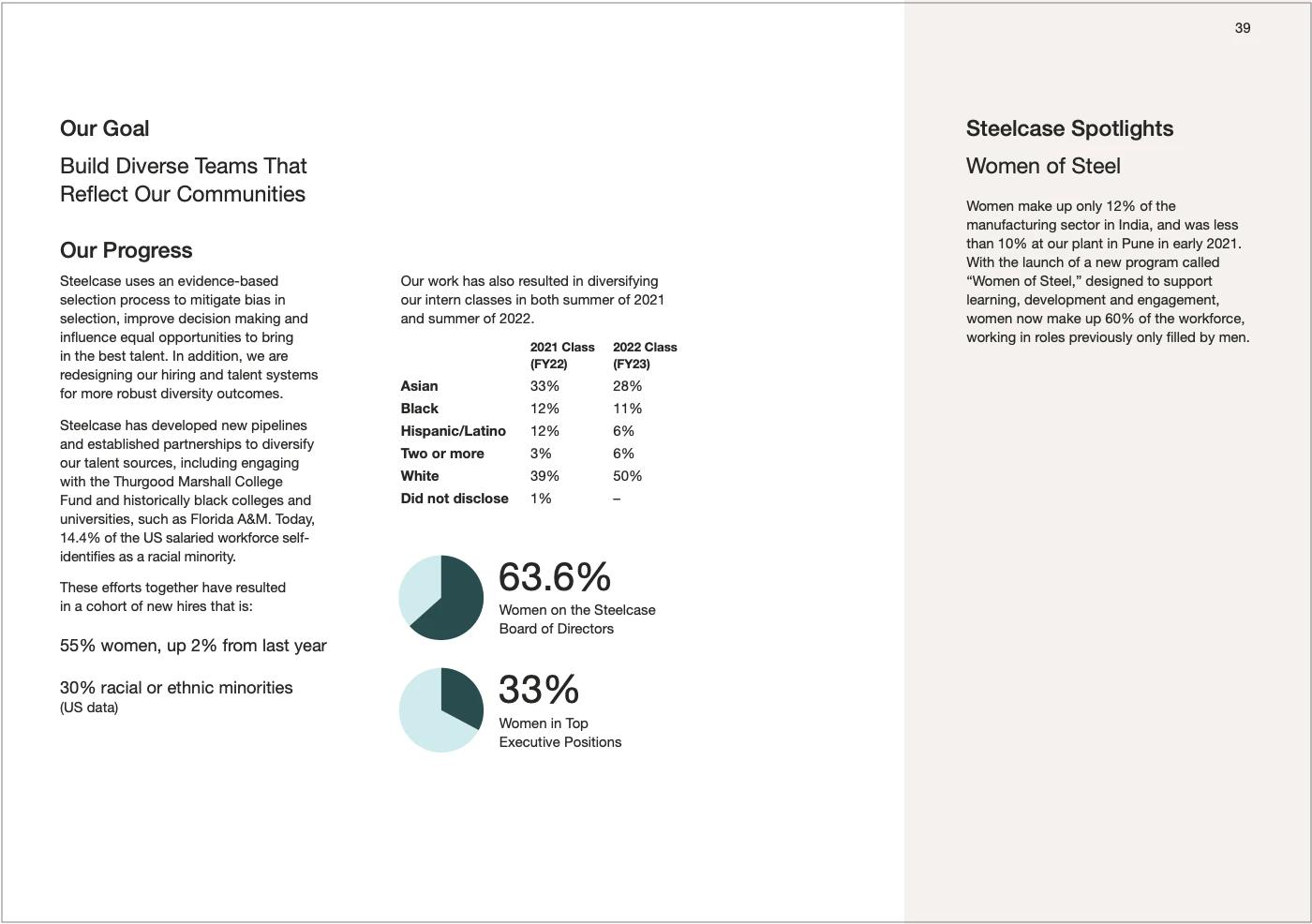
Steelcase’s 2022 Impact Report very simply shows the percentage of women in top positions and a breakdown of the race and ethnicity of interns across 2021 and 2022.
As you start to work with your finance and human resource teams, it’s a great opportunity to build greater understanding around the data that is required for the company’s reporting. This helps ensure that data gathering not only does not become siloed but rather helps develop relationships across departments that support your company’s growth into sustainability.
The social side

Room & Board’s 2023 Impact Report describes some of the events and activities it has taken part in over the year including supporting BIPOC & LGBTQ+ designers and tree planting for Arbor Day.

This report from Teknion clearly details all the metrics and measurements used in their 2024 ESG Report, and how each relates to the SASB reporting framework. The excerpt above, for example, shows that 95% of total wood purchased is from FSC certified sources. This is a key facet of wood supply-chain management.
Where to look for the data you need
Here are a host of examples of which departments might be able to provide you with the data you need to build and track a clear picture of your impacts:
- Finance or Accounts - invoices for utility bills, fuel usage, water use, travel, staff bonuses, pensions and fair pay
- Purchasing - material sourcing (packaging and raw materials), responsible procurement practice, sustainable timber, paper use and local sourcing
- Human Resources - internal recruitment, internal promotions, managerial positions by gender, gender pay gap, staff training and development, staff wellbeing programs, employee benefits, health insurance, vacation and DEI (diversity, equity and inclusion)
- Operations or Production - waste generation, electricity use, transport and logistics
- Waste management provider - landfill diversion rate, and waste weights by type (metal, plastic, cardboard etc.)
- Design - information on product design and end-of-life, circular economy, renewable content, recycled content, recyclable content of products, and material health of products, including health and wellbeing of consumers and workers
- Sales - customer feedback and engagement
- Marketing - ethical marketing practices
- Community engagement team - volunteering and community based activities, donations and philanthropic efforts
- Compliance - environmental and social compliance, certified timber, inbound and outbound plastic packaging, certified products, occupational health and safety, product safety, membership of professional associations, accreditations (e.g. ISO 14001 and 9001), governance issues and policy (anti-bribery and corruption, grievance procedure, whistleblowing policy, environmental policy, transparency and disclosure), data protection and privacy and nuisance management
- Sustainability - site biodiversity, regeneration plans, carbon accounting, water stewardship and … much of the above!

In conclusion
Once you have gathered data for your highest priority material topics, you will need to ask yourself - what does this data show me about my company? Evaluation of this data is key - if this is not your forte, get someone analytical to help - remember that understanding your impacts is the most important bit, not the data itself.
Often, gathering the data shines a light on opportunities to make significant financial savings. If you see that travel-related emissions are high, you can set a target to reduce flights and reduce your travel budget at the same time. Seeing that electricity is being wasted can lead to efficiencies that will reduce bills. If your waste is too high you can look at ways of using materials more efficiently, buying less and paying less for waste management. In part 3 of this series we will take a look at how impacts can be mitigated in a way that opens up opportunities to help direct your sustainability strategy.
Impact reporting is not easy. It takes time and effort to understand your impacts and find ways of measuring them. Every company will prioritize impacts differently – depending on the scale of each impact, its influence on value creation and the importance stakeholders place upon them. Prioritization needs to be updated and reviewed by those at the highest level of company decision-making. Most importantly, make sure that the impact report itself does not become the aim but rather a key tool to help drive change. Focus on offering human-centered solutions that add up to a roadmap for change.
WATCH Webinar #2:
Up next, READ Action Guide #3: Opportunities for change
If you missed it, READ Action Guide #1: The What, How and Why of Impact Reporting
WATCH Webinar #1:
SOURCES
Conducting a Materiality Assessment
Sustainability Materiality Matrices Explained
IKEA Global Stakeholder Engagement
World Business Council for Sustainable Development
GRI: Business Reporting on the SDGs - An Analysis of the Goals and targets: 2022

